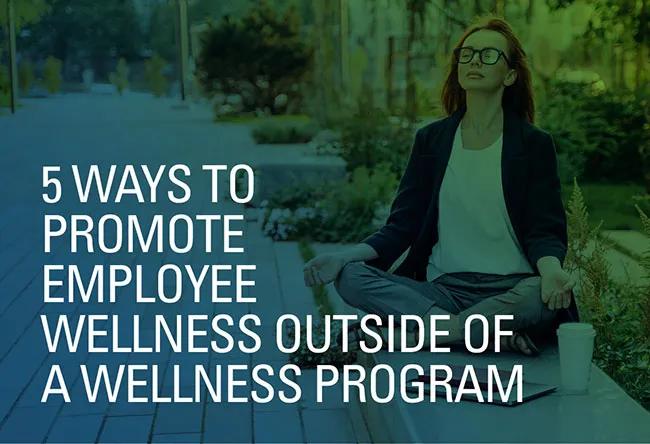
5 Ways to Promote Employee Wellness Outside of a Wellness Program

Additional Ways to Help Your Healthcare Staff Feel Better Mentally and Physically
More than four in five larger companies offer some type of workplace wellness program.1 These programs can be a good way to help employees improve their mental and physical well-being while also increasing performance levels and reducing turnover rates.2 Finding even more ways to promote employee wellness outside of a structured program may help further these benefits. Here are a few options to consider.
1. Offer Fitness Equipment in Breakrooms
Some wellness programs offer employees access to a local fitness center or gym at a reduced rate. Although this can make membership to these facilities more affordable, it still requires that employees take the time — and make the commitment — to go to these locations and exercise.
Since 6.1 million people in the U.S. have gym memberships that they don’t use,3 simply providing reduced-cost access may not be enough. Also giving employees other ways to stay fit can help them enjoy the many benefits that regular workouts have to offer without worrying about how to add one more thing to their already packed schedule.
Equipping breakrooms with various fitness devices such as treadmills, stationary bikes, and hand weights is one option. If exercise equipment is available on-site, employees with busy after-work schedules can get in some type of physical activity during their daytime breaks. This can help them develop an exercise habit without worrying about what they have to cut out of their life to add a fitness activity in.
It can also be helpful to put posters on the breakroom wall that highlight the benefits of regular physical exercise or that show your employees how to work out with proper form. A poster that outlines a quick break time exercise routine can also give your employees a place to start if they’re not sure what to do.
2. Provide an On-Site Meditation Room
Sometimes, employees may benefit from slowing their bodies and minds down instead of speeding them up with exercise. In this case, providing a room where they can go, close their eyes, and meditate for a few minutes presents them with this option.
Research shows that engaging in mindfulness meditation offers many benefits for healthcare employees, some of which include potentially reducing anxiety, depression, and burnout.4 Meditation can give them a moment to relax during a hectic workday or help them ease their mind when faced with a troublesome situation.
Dimmable lights, soothing music, and calming pictures can help create a more pleasing meditation experience. Having a sign on the outside of the door that indicates when the room is occupied also enables staff to fully dive into the meditation without risk of being interrupted.
3. Give Access to Wellness Apps and Webinars
If your healthcare organization has remote workers, finding virtual wellness options helps you better reach this demographic. Wellness apps can be a good choice, as can online webinars that provide tips designed to solve the employee’s greatest health-related concerns, such as those that focus on how to quit smoking, reduce stress, or ways to better manage stress.
For instance, the Virgin Pulse app helps users develop positive health habits and retain them long-term. It does this by breaking lifestyle changes down into smaller, more manageable chunks. Users are also able to track their progress, which can motivate them to continue.
The Headspace app is another option created specifically for the workplace. This app guides the user through meditations and other exercises created to reduce their stress, improve their focus, and more.
The National Institutes of Health Office of Human Resources also provides access to a variety of free on-demand webinars. Some focus on nutrition or exercise, others talk about weight loss, disease prevention, or how to age gracefully. With multiple topics from which to choose, employees can watch the webinars that are of most interest to them.
4. Participate In Group Charity Events
Volunteering for a charity that you care about can be rewarding. It also creates greater feelings of belonging in the community, enhances social support, and improves wellbeing.5 One way to give your employees access to all these benefits is to participate in a charity event as a group.
If your employees have a passion for people with cancer, for instance, the American Cancer Society sponsors many local Relay for Life events. Ask interested staff members to sign up, come up with a group name, raise funds for donation, and participate in the event.
In a more rural area with somewhat limited access to some of the larger charity events? You can also create your own. Talk to a local group that could benefit from a bit of fundraising and work together to come up with an event that your employees could participate in. You could even ask your staff which organizations they’d like to help support, then work to help a different one each month, quarter, or year.
5. Encourage Social Support
One study involving 96 healthcare workers (hospital nurses) found that when these workers faced incivility during the workday, they were more likely to experience emotional exhaustion after work, along with a reduction in vitality and positive affect.6 Conversely, if the workers also had social support during the workday, they had higher levels of well-being – with the social support even buffering the negative effects of a sometimes-uncivil workplace.
Johns Hopkins suggests that establishing a strong social support network requires identifying at least one person who can do each of the following:7
- Provide physical assistance
- Provide emotional assistance
- Provide a positive attitude
- Provide information or access to resources
Depending on the employee’s network, this person may be a family member, friend, church member, or social services worker. It doesn’t matter so much who the person is or how they are connected to the employee, but more so that they supply the social support that the staff member needs to feel cared for, valued, and loved.
How Can UMA Help?
At Ultimate Medical Academy (UMA), we are focused on helping our healthcare partners continue the model of care, caring for their employees so that their employees can then care for their patients.
If you are looking for more ways to promote employee wellness, contact us today. We are here to help in any way we can, including offering guidance on how to attract and retain healthcare talent.
1 Pollitz K, Rae M. Trends in Workplace Wellness Programs and Evolving Federal Standards. Kaiser Family Foundation. https://www.kff.org/private-insurance/issue-brief/trends-in-workplace-wellness-programs-and-evolving-federal-standards/
2 Ott-Holland CJ, Shepherd, WJ, Ryan AM. Examining Wellness Programs Over Time: Predicting Participation and Workplace Outcomes. Journal of Occupational Health Psychology. https://doi.org/10.1037/ocp0000096
3 Laycock R, Choi C. Americans spend $397 million on unused gym memberships annually. Finder. https://www.finder.com/unused-gym-memberships
4 Hilton L, et al. Mindfulness Meditation for Workplace Wellness: An Evidence Map. Work. https://content.iospress.com/articles/work/wor192922
5 Bowe M, et al. A Social Cure in the Community: A Mixed-Method Exploration of the Role of Social Identity in the Experiences and Well-Being of Community Volunteers
6 Carmona-Cobo I, Lopez-Zafra E. Hospital Nurses Experiencing Day-to-Day Workplace Incivility: A Diary Study on the Benefits of Daily Social Support. Journal of Nursing Management. https://doi.org/10.1111/jonm.13510
7Johns Hopkins Medicine. Social Support Systems. https://www.hopkinsmedicine.org/about/community_health/johns-hopkins-bayview/services/called_to_care/social_support_systems.html
About the Author
 Lindsay England
Lindsay EnglandLindsay England is the Senior Director of Operations at Ultimate Medical Academy’s Career Services Department, and has been with UMA for 6 years. She helps to oversee all of the daily operations within the department, support the staff with achieving successful student outcomes, and lead numerous support functions that contribute to graduate placement efforts.

